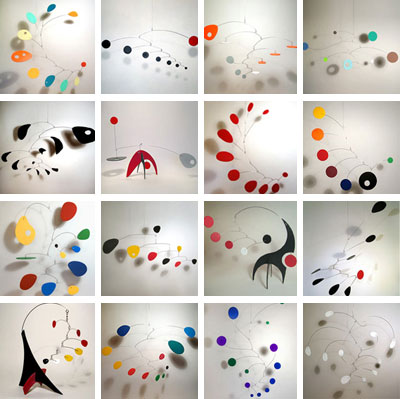Art Mobiles - Connection
A New High School and a new MOBILE!!
For nearly the last three years, the entire town wanted to know what the brand new, 83,000 square foot facility would look like.
The original high school was destroyed after power lines fell on the building and started a fire in the 2007 ice storm.
Watch this video of the local newsHappy Birthday Alexander Calder!

Google doodle goes mobile for Alexander Calder's 113th birthday.
Friday's Google doodle shows a mobile, a type of kinetic sculpture that was invented by Alexander Calder. Mobiles take advantage of the principle of equilibrium and have objects hanging from rods. Kinetic art uses motion for an artistic effect.
Mobiles are usually brightly coloured free-moving creations in abstract shapes made from sheet metal. The mobile Google doodle sways on its own and can also be controlled by mouse gestures.
Calder was born on July 22, 1898 in Lawnton, US to a family of artists. While his father and grandfather were both sculptors, his mother was a painter.
He graduated with a degree in mechanical engineering from the Stevens Institute of Technology in Hoboken, New Jersey, in 1919. He then took art lessons. After a brief career in commercial art, Calder moved to Paris and put up an exhibition of a miniature circus with toy-like animals made of wood and wire. In Paris he formed associations with renowned artists and their influence helped him shape his art.
Calder was also a jewellery designer, an interest that developed when he was fashioning a wedding ring for his marriage with Louisa Cushing James. Besides his sculptures, Calder also illustrated a number of books. Besides mobiles, he also earned a name with stabiles, a type of stationary abstract sculptures.
With the years Calder also scaled up the size of his mobile and stabile installations. Calder died at the age of 78 on November 11, 1976. Two months after his death, Calder was honoured with United States' highest civilian honour, the Presidential Medal of Freedom.
Interactive and animated Google doodles have now become a regular feature on the Google home page. The last such doodle was during the total lunar eclipse of June 15-16 when Google put up its first live doodle that refreshed itself every two minutes to reflect the stage of the moon.
For a dozen years, Google has been occasionally swapping its everyday logo for a doodle, a sketch celebrating holidays, inventions, artists and sporting events, and showcasing designs from contest-winning students.
For a look at contemporary mobile designs .... come see modern mobile artist Julie Frith: www.frithmobiles.com
Best Baby Mobiles 2010
Wikipedia: Mobile (sculpture)
The sculptor Alexander Calder is well known for his mobiles. Calder invented the mobile in 1931. Marcel Duchamp suggested the name "mobile".[1] Mobiles are also popular in the nursery, where they hang over cribs to give infants something to entertain them and give them external visual stimulation.
The meaning of the term “mobile” as applied to sculpture has evolved since it was first suggested by Marcel Duchamp in 1931 to describe the early, mechanized creations of Alexander Calder. At this point, “mobile” was synonymous with the term “kinetic art”, describing sculptural works in which motion is a defining property. While motor or crank-driven moving sculptures may have initially prompted it, the word “mobile” later came to refer more specifically to Calder’s free-moving creations. Influenced by the abstract work of Piet Mondrian, Joan Miró and Sophie Taeuber-Arp, Calder in many respects invented an art form where objects (typically brightly coloured, abstract shapes fashioned from sheet metal) are connected by wire much like a balance scale. By the sequential attachment of additional objects, the final creation consists of many balanced parts joined by lengths of wire whose individual elements are capable of moving independently or as a whole when prompted by air movement or direct contact. Thus, “mobile” has become a more well-defined term referring to the many such hanging constructs Calder produced in a prolific manner between the 1930s and his death in 1976. A succinct definition of the term “mobile” in a visual art sense could be a type of kinetic sculpture in which an ensemble of balanced parts capable of motion are hung freely in space.What is an art mobile?

Frithmobiles: Mobiles by Julie Frith
Mobile (art), in art, type of sculpture characterized by the ability to move when propelled by air currents, by touch, or by a small motor at any one time. The most striking feature of the mobile is that, unlike traditional sculpture, it achieves its artistic effect through movement; it is the most familiar form of kinetic art, which requires movement of some kind. A typical mobile consists of a group of shapes, frequently abstract, that are connected by wires, string, metal rods, or the like. Although mobiles are usually suspended, some are designed to stand on a platform or floor. The first experimental mobiles were the work of the French artist Marcel Duchamp in the 1920s.The form, however, was developed to its finest expression so far by the American sculptor Alexander Calder, beginning in the 1930s. written by Marco Mahler










